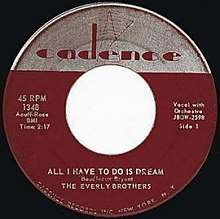All I Have to Do Is Dream
| "All I Have to Do Is Dream" | ||||
|---|---|---|---|---|
 | ||||
| Single by The Everly Brothers | ||||
| B-side | "Claudette" | |||
| Released | April 1958 | |||
| Format | 45 rpm, 78 rpm | |||
| Recorded | March 6, 1958, RCA Studios, Nashville, Tennessee | |||
| Genre | Jangle pop[1] | |||
| Length | 2:17 | |||
| Label | Cadence 1348 | |||
| Songwriter(s) | Boudleaux Bryant | |||
| The Everly Brothers singles chronology | ||||
| ||||
"All I Have to Do Is Dream" is a song made famous by the Everly Brothers, written by Boudleaux Bryant of the husband and wife songwriting team Felice and Boudleaux Bryant,[2] and published in 1958. The song is ranked No. 141 on the Rolling Stone magazine's list of The 500 Greatest Songs of All Time. The song is in AABA form.[3]
The Everly Brothers' version
By far the best-known version was recorded by The Everly Brothers[2] and released as a single in April 1958. It had been recorded by The Everly Brothers live in just two takes[4] on March 6, 1958, and features Chet Atkins on guitar. It was the only single ever to be at No. 1 on all of the Billboard singles charts simultaneously, on June 2, 1958. It first reached No. 1 on the "Most played by Jockeys" and "Top 100" charts on May 19, 1958, and remained there for five and three weeks, respectively; with the August 1958 introduction of the Billboard Hot 100 chart, the song ended the year at No. 2. "All I Have to Do Is Dream" also hit No.1 on the R&B chart[5] as well as becoming The Everly Brothers' third chart topper on the country chart.[6] The Everly Brothers briefly returned to the Hot 100 in 1961 with this song. It entered the U.K. Singles Chart on May 23, 1958, reaching the No. 1 position on July 4 and remaining there for seven weeks (including one week as a joint No. 1 with Vic Damone's "On the Street Where You Live"), spending 21 weeks on the chart.[7]
The song has also featured on several notable lists of the best songs or singles of all time, including Q's 1001 best songs ever in 2003. It was named one of the "500 Songs that Shaped Rock and Roll" by the Rock and Roll Hall of Fame and received the Grammy Hall of Fame Award in 2004.
The B-side, "Claudette", was the first major song writing success for Roy Orbison (who also recorded his own version of the song) and was named after his first wife.[8] As a result of this success Orbison terminated his contract with Sun Records and affiliated himself with the Everly's publisher, Acuff-Rose Music.
The Everly Brothers' version of "All I Have to Do Is Dream" is featured rather prominently in the 2001 film Riding in Cars with Boys: first the original recording is heard when the father (James Woods) is driving his young daughter (Mika Boorem), who is singing along; at the end of the film the father and the daughter (Drew Barrymore) jointly are singing their beloved oldie whilst huddling together and reminiscing.
The song appears in the game Mafia II, even though the game is set in 1951, seven years before the song was released.
The song also appears at the credits of the 1999 HBO special adaptation of Goodnight Moon.
This version of the song was also included at the end credits of the 2010 remake of A Nightmare on Elm Street.
Cover versions
| "All I Have to Do Is Dream" | ||||
|---|---|---|---|---|
| Single by Richard Chamberlain | ||||
| from the album Richard Chamberlain Sings | ||||
| B-side | "Hi-Lili, Hi-Lo" | |||
| Released | 1963 | |||
| Format | 7-inch single | |||
| Length | 2:30 | |||
| Label | MGM | |||
| Songwriter(s) | Boudleaux Bryant | |||
| Richard Chamberlain singles chronology | ||||
| ||||
Richard Chamberlain covered the song on his 1962 album Richard Chamberlain Sings. Released as a single in 1963, it peaked at #14 on the Billboard Hot 100 chart, and at #6 on the Billboard Adult Contemporary chart.
Bobbie Gentry and Glen Campbell released a duet version 1969 (#27 Hot 100, #6 Country, #4 Adult Contemporary, #3 U.K., #6 Sweden, #3 South Africa).
The Nitty Gritty Dirt Band's version hit #66 on the Billboard Hot 100 in 1975.
Cliff Richard, singing with Phil Everly of the Everly Brothers, took the song to #14 on the U.K. Singles Chart in 1994.
References
- ↑ LaBate, Steve (December 18, 2009). "Jangle Bell Rock: A Chronological (Non-Holiday) Anthology… from The Beatles and Byrds to R.E.M. and Beyond". Paste. Retrieved July 24, 2016.
- 1 2 The Everly Brothers interviewed on the Pop Chronicles (1969)
- ↑ Covach, John (2005), "Form in Rock Music: A Primer", in Stein, Deborah, Engaging Music: Essays in Music Analysis, New York: Oxford University Press, p.70, ISBN 0-19-517010-5 .
- ↑ Archived November 3, 2005, at the Wayback Machine.
- ↑ Whitburn, Joel (2004). Top R&B/Hip-Hop Singles: 1942-2004. Record Research. p. 194.
- ↑ Whitburn, Joel (2004). The Billboard Book Of Top 40 Country Hits: 1944-2006, Second edition. Record Research. p. 117.
- ↑ Roberts, David (2006). British Hit Singles & Albums (19th ed.). London: Guinness World Records Limited. pp. 86–8. ISBN 1-904994-10-5.
- ↑ Rice, Jo (1982). The Guinness Book of 500 Number One Hits (1st ed.). Enfield, Middlesex: Guinness Superlatives Ltd. pp. 37–8. ISBN 0-85112-250-7.